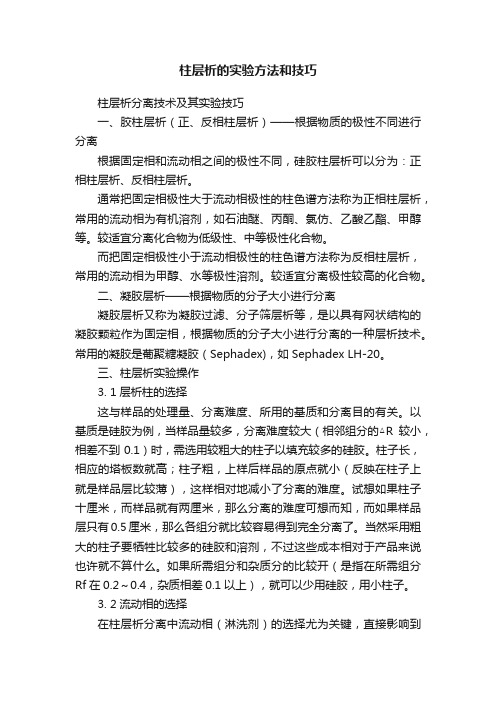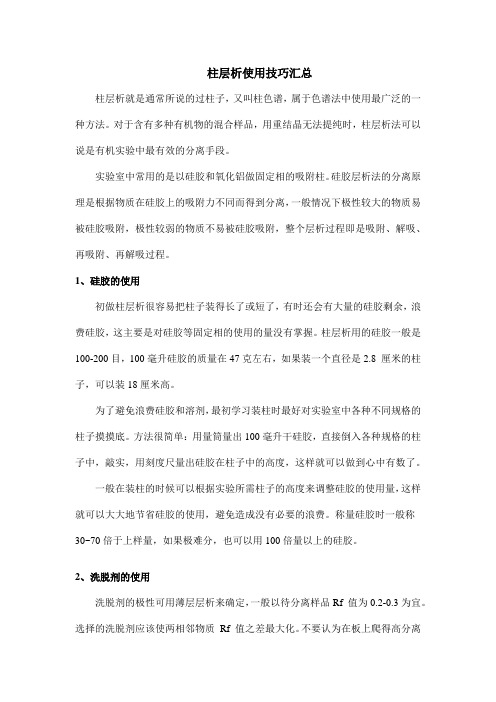快速柱层析技巧
柱层析的实验方法和技巧

柱层析的实验方法和技巧柱层析分离技术及其实验技巧一、胶柱层析(正、反相柱层析)——根据物质的极性不同进行分离根据固定相和流动相之间的极性不同,硅胶柱层析可以分为:正相柱层析、反相柱层析。
通常把固定相极性大于流动相极性的柱色谱方法称为正相柱层析,常用的流动相为有机溶剂,如石油醚、丙酮、氯仿、乙酸乙酯、甲醇等。
较适宜分离化合物为低级性、中等极性化合物。
而把固定相极性小于流动相极性的柱色谱方法称为反相柱层析,常用的流动相为甲醇、水等极性溶剂。
较适宜分离极性较高的化合物。
二、凝胶层析——根据物质的分子大小进行分离凝胶层析又称为凝胶过滤、分子筛层析等,是以具有网状结构的凝胶颗粒作为固定相,根据物质的分子大小进行分离的一种层析技术。
常用的凝胶是葡聚糖凝胶(Sephadex),如Sephadex LH-20。
三、柱层析实验操作3. 1层析柱的选择这与样品的处理量、分离难度、所用的基质和分离目的有关。
以基质是硅胶为例,当样品量较多,分离难度较大(相邻组分的△R较小,相差不到0.1)时,需选用较粗大的柱子以填充较多的硅胶。
柱子长,相应的塔板数就高;柱子粗,上样后样品的原点就小(反映在柱子上就是样品层比较薄),这样相对地减小了分离的难度。
试想如果柱子十厘米,而样品就有两厘米,那么分离的难度可想而知,而如果样品层只有0.5厘米,那么各组分就比较容易得到完全分离了。
当然采用粗大的柱子要牺牲比较多的硅胶和溶剂,不过这些成本相对于产品来说也许就不算什么。
如果所需组分和杂质分的比较开(是指在所需组分Rf在0.2~0.4,杂质相差0.1以上),就可以少用硅胶,用小柱子。
3. 2流动相的选择在柱层析分离中流动相(淋洗剂)的选择尤为关键,直接影响到柱层析的分离效果,如果选择不当常常导致几十毫克样品,用了几百毫升淋洗剂都还没有完全分离,甚至不能分离。
以硅胶柱为例,具体选择哪种流动相以及流动相的极性,多是通过薄层色谱(TLC)来确定。
柱层析的方法与技巧

柱层析操作柱层析操作方法与技巧方法与技巧方法与技巧摘要:本文主要论述的是柱层析的试验方法和技巧。
关键词:柱层析 方法 技巧1.1.柱层析的介绍与原理柱层析的介绍与原理柱层析的介绍与原理::常说的过柱子应该叫柱层析分离,也叫柱色谱。
我们常用的是以硅胶或氧化铝作固定相的吸附柱。
见图1图1硅胶层析法的分离原理是根据物质在硅胶上的吸附力不同而得到分离, 一般情况下极性较大的物质易被硅胶吸附,所以流动较慢,极性较弱的物质不易被硅胶吸附,所以流动较快。
从而达到分离的效果。
整个层析过程即是吸附、解吸、再吸附、再解吸过程。
整个简单流程示意图如图2图22.2.柱层析的操作方法与技巧柱层析的操作方法与技巧柱层析的操作方法与技巧::1、柱子可以分为:加压,常压,减压压力可以增加淋洗剂的流动速度,减少产品收集的时间,但是会减低柱子的塔板数。
所以其他条件相同的时候,常压柱是效率最高的,但是时间也最长,比如天然化合物的分离,一个柱子几个月也是有的。
减压柱能够减少硅胶的使用量,感觉能够节省一半甚至更多,但是由于大量的空气通过硅胶会使溶剂挥发(有时在柱子外面有水汽凝结),以及有些比较易分解的东西可能得不到,而且还必须同时使用水泵抽气(很大的噪音,而且时间长)。
加压柱是一种比较好的方法,与常压柱类似,只不过外加压力使淋洗剂走的快些。
压力的提供可以是压缩空气,双连球或者小气泵(给鱼缸供气的就行)。
特别是在容易分解的样品的分离中适用。
压力不可过大,不然溶剂走的太快就会减低分离效果。
个人觉得加压柱在普通的有机化合物的分离中是比较适用的。
2、关于柱子的尺寸,应该是粗长的最好柱子长了,相应的塔板数就高。
柱子粗了,上样后样品的原点就小(反映在柱子上就是样品层比较薄),这样相对的减小了分离的难度。
试想如果柱子十厘米,而样品就有二厘米,那么分离的难度可想而知,恐怕要用很低极性的溶剂慢慢冲了。
而如果样品层只有0.5厘米,那么各组分就比较容易得到完全分离了。
柱层析的注意事项

柱层析的注意事项柱层析的注意事项如下:1、装柱。
柱子下面的活塞一定不要涂润滑剂,会被淋洗剂带到产品中的,可以采用四氟节门的。
干法和湿法装柱觉得没什么区别,只要能把柱子装实就行。
装完的柱子应该要适度的紧密(太密了淋洗剂走的太慢),一定要均匀(不然样品就会从一侧斜着下来)。
书中写的都是不能见到气泡,我觉得在大多数情况下有些小气泡没太大的影响,一加压气泡就全下来了。
当然假如你装的柱子总是有气泡就说明需要多练习了。
但是柱子更忌讳的是开裂,甭管竖的还是横的,都会影响分离效果,甚至作废!2、加样。
用少量的溶剂溶样品加样,加完后将下面的活塞打开,待溶剂层下降至石英砂面时,再加少量的低极性溶剂,然后加入淋洗剂,一开始不要加压,等溶样品的溶剂和样品层有一段距离(2~4cm就够了),再加压,这样避免了溶剂(如二氯甲烷等)夹带样品快速下行。
3、淋洗剂的选择。
感觉上要使所需点在rf0.2~0.3左右的比较好。
不要认为在板上爬高了分的比较开,过柱子就用那种极性,假如rf在0.6,即使相差0.2也不轻易在柱子上分开,因为柱子是一个多次爬板的状态,可以通过公式的比较:0.6/0.8一次的分离度,肯定不如(0.2/0.3)的三次方或四次方大。
4、样品的收集。
用硅胶作固定相过柱子的原理是一个吸附与解吸的平衡。
所以假如样品与硅胶的吸附比较强的话,就不轻易流出。
这样就会发生,后面的点先出,而前面的点后出。
这时可以采用氧化铝作固定相。
另外,收集的试管大小要以样品量而定,非凡是小量样品,假如用大试管,可能一根就收到了三个样品,假如都用小试管那工作量又太大。
5、最后的处理。
柱分后的产品,由于使用了大量的溶剂,其中的杂质也会累积到产品中,所以假如想送分析,最好用少量的溶剂洗涤一下,因为大部分的杂质是溶在溶剂里的,一洗基本就没了,必要时进行重结晶。
另外,再过柱的时候,有时会出现气泡,一是和使用的溶剂有关,假如是易挥发的溶剂,如乙醚、二氯甲烷等,在室温稍高的情况下,很轻易出现这种现象,因此,在室温高的时候,可以选择沸点较高,挥发相对小的溶剂。
flash柱层析使用方法

flash柱层析使用方法Flash柱层析(Flash column chromatography)是一种常用于分离和纯化化合物的柱层析技术。
它基于分子在柱填料中的亲疏水性差异,通过溶剂的流动将混合物中的组分分离开来。
本文将介绍Flash柱层析的使用方法,帮助读者了解如何正确操作和利用该技术。
一、实验前的准备工作1. 选择合适的柱层析填料:根据待分离物的特性选择合适的填料,如硅胶、C18等。
2. 准备溶剂系统:根据待分离物的亲疏水性选择合适的溶剂体系,通常是两种或多种溶剂的混合物。
3. 预先准备好样品:将待分离物溶解在适当的溶剂中,并过滤以去除杂质。
4. 准备好适当大小的柱:根据样品量选择合适大小的柱,并用柱层析填料填充。
二、Flash柱层析的操作步骤1. 装填填料:将柱用适当溶剂洗涤,并用适当溶剂进行湿润,然后将填料装入柱中,注意不要产生气泡。
2. 将样品溶液加入柱中:用移液管将样品溶液缓慢地加入柱中,避免样品直接接触填料,以免影响分离效果。
3. 选择适当的溶剂流动速度:通过控制溶剂流速,使得样品在填料中适当停留时间,以实现有效分离。
4. 收集不同组分的洗脱液:根据待分离物的特性和溶剂系统的选择,调整洗脱液的组成和流速,以实现不同组分的分离和纯化。
5. 检测和收集目标化合物:使用合适的检测方法(如紫外可见光谱、质谱等)检测出目标化合物的洗脱峰,并及时收集。
6. 柱层析结束后的处理:将柱层析填料彻底洗净,并存放在适当的条件下,以备下次使用。
三、注意事项和常见问题1. 溶剂选择:根据样品的特性选择合适的溶剂系统,避免溶剂与填料发生反应或影响分离效果。
2. 填料的选择和装填:根据待分离物的特性选择合适的填料,并注意填充的均匀性和密实度。
3. 柱层析过程中的压力控制:避免柱层析过程中产生过高的压力,以免破坏柱和填料。
4. 分离效果的评估:通过监测洗脱液的波谱、质谱等检测方法,评估分离效果和纯化程度。
5. 样品的负荷量:根据填料的大小和待分离物的量选择合适的样品负荷量,避免超过填料的吸附容量。
柱层析使用技巧汇总

柱层析使用技巧汇总柱层析就是通常所说的过柱子,又叫柱色谱,属于色谱法中使用最广泛的一种方法。
对于含有多种有机物的混合样品,用重结晶无法提纯时,柱层析法可以说是有机实验中最有效的分离手段。
实验室中常用的是以硅胶和氧化铝做固定相的吸附柱。
硅胶层析法的分离原理是根据物质在硅胶上的吸附力不同而得到分离,一般情况下极性较大的物质易被硅胶吸附,极性较弱的物质不易被硅胶吸附,整个层析过程即是吸附、解吸、再吸附、再解吸过程。
1、硅胶的使用初做柱层析很容易把柱子装得长了或短了,有时还会有大量的硅胶剩余,浪费硅胶,这主要是对硅胶等固定相的使用的量没有掌握。
柱层析用的硅胶一般是100-200目,100毫升硅胶的质量在47克左右,如果装一个直径是2.8 厘米的柱子,可以装18厘米高。
为了避免浪费硅胶和溶剂,最初学习装柱时最好对实验室中各种不同规格的柱子摸摸底。
方法很简单:用量筒量出100毫升干硅胶,直接倒入各种规格的柱子中,敲实,用刻度尺量出硅胶在柱子中的高度,这样就可以做到心中有数了。
一般在装柱的时候可以根据实验所需柱子的高度来调整硅胶的使用量,这样就可以大大地节省硅胶的使用,避免造成没有必要的浪费。
称量硅胶时一般称30~70倍于上样量,如果极难分,也可以用100倍量以上的硅胶。
2、洗脱剂的使用洗脱剂的极性可用薄层层析来确定,一般以待分离样品Rf 值为0.2-0.3为宜。
选择的洗脱剂应该使两相邻物质Rf 值之差最大化。
不要认为在板上爬得高分离的效果就比较好,如果Rf 在0.6,即使相差0.2 也不容易在柱子上分开,因为柱子是一个多次爬板的过程,可以通过公式的比较:0.6/0.8 一次的分离度,肯定不如(0.2/0.3)的三次方或四次方大。
有时虽然在薄层板上看到分离的效果很好,但过柱层析时还是很难分开。
这主要的原因就是薄层层析用硅胶比柱层析用硅胶要细得多,所以分离效果好。
解决的办法就是降低洗脱剂的极性,一般柱层析用洗脱剂比薄层层析用的展开剂极性要再降低一倍可以达到比较好的分离效果。
柱层析的操作步骤和注意事项

精心整理柱层析技术常说的过柱子应该叫柱层析分离,也叫柱色谱。
我们常用的是以硅胶或氧化铝作固定相的吸附柱。
由于柱分的经验成分太多,所以下面我就几年来过柱的体会写些心得,希望能有所帮助。
柱子可以分为:加压,常压,减压。
压力可以增加淋洗剂的流动速度,减少产品收集的时间,但是会减低柱子的塔板数。
所以其他条件相同的时候,常压柱是效率最高的,但是时间也最长,比如天然化合物的分离,一个柱子几个月也是有的。
头了。
有0.5相差0.1是因为分离的东西比较敏感,所以接收瓶一定要用可密封的,遵循schlenk操作。
至于是加压、常压、减压,随需而定。
因为是schlenk操作,所以点板是个问题,假如样品是显色的,恭喜了,不用点板,直接看柱子上的色带就行了。
假如样品无色,只好预备几十个schlenk瓶,一瓶一瓶的点,不过几次之后就知道样品在哪,也就可以省些了。
像我以前过一根无水无氧柱,需要六个schlenk,现在只一个就能把所要的全收集到。
无水无氧柱中用的比较多的是用氧化铝作固定相。
因为硅胶中有大量的羟基裸露在外,很轻易是样品分解,非凡是金属有机化合物和含磷化合物。
而氧化铝可以做成碱性、中性和酸性的,选择余地比较大,但是比硅胶要贵些。
听说有个方法,就是用石英做柱子,然后用HF254做固定相,这样在柱子外面用紫外灯一照就知道产品在哪里了,没有验证过。
哪位做过可以提出来大家参详参详。
--※关于湿法、干法上样。
湿法省事,一般用淋洗剂溶解样品,也可以用二氯甲烷、乙酸乙酯等,但溶剂越少越好,不然溶剂就成了淋洗剂了。
很多样品在上柱前是粘乎乎的,一般没关系。
可是有的上样后在硅胶上又会析出,这一般都是比较大量的样品才会出现,是因为硅胶对样品的吸附饱和,而样品本身又是比较好的固体才会发生,这就应该先重结晶,得到大部分的产品后再柱分,假如不能重结晶那就不管它了,直接过就是了,样品随着淋洗剂流动会溶解的。
有些样品溶解性差,能溶解的溶剂又不能上柱(比如DMF,DMSO等,会随着溶剂一起走,显色是一个很长的脱尾),这时就必须用干法上柱了。
关于柱层析的实验方法和技巧

关于柱层析的实验方法和技巧柱层析是一种广泛应用于分离、纯化和分析复杂混合物的技术。
其基本原理是根据混合物组分的相互作用力的不同,在柱状填料上发生不同程度的分配与吸附,从而使混合物分离成单个或少量组分。
柱层析实验方法主要包括以下步骤:1.选择柱层析填料:根据所需分离的混合物的特性和目的,选择合适的填料。
常用填料有硅胶、反相填料等。
2.准备样品:将待分离的混合物以适当的溶剂溶解,并过滤除去悬浮物。
3.将填料装入层析柱中:将选择好的填料按照提供的方法装入层析柱,并确保填充完全均匀。
4.平衡填料:用适当的洗脱剂通过填料进行平衡,以除去填料表面的杂质和待分离混合物外的其他杂质。
5.加样分析:在柱层析填料上均匀加样,并注意避免柱尾部的重叠现象,以免影响分离效果。
6.洗脱剂流出:用相应的洗脱剂缓慢流过填料层,将待分离的组分逐渐从填料中洗脱出来。
7.采集分离组分:根据所需分离组分的不同,采用不同的方法收集和提取洗脱液中的分离组分。
8.结果分析:通过检测和分析分离得到的组分,确定柱层析的分离效果,并进一步进行定量分析或纯化操作。
柱层析实验中的技巧有:1.选择合适的填料和洗脱剂:填料的选择应考虑到混合物的性质和目的,洗脱剂的选择应使待分离的组分具有较大的差异性。
2.注意填料装填的均匀性:填料装填均匀可以提高柱层析的分离效果和分辨率,避免填料不均匀造成的漏洗现象。
3.适当控制洗脱剂的流速:流速过快会导致分离不彻底,流速过慢则会延长分析时间。
应根据填料和样品特性调整流速。
4.注意样品加样的均匀性:样品加样均匀可以避免出现分离过早或过晚的现象,影响柱层析的分离效果。
5.经常检查柱的状态和泄漏情况:柱层析过程中,需要时常检查柱的状态,如填料是否松动、泄漏等,及时发现和处理问题。
6.根据分离效果调整实验参数:根据分离效果的实际情况,进行必要的参数调整,如填料种类、洗脱剂浓度、流速等。
flash柱层析使用方法

flash柱层析使用方法(原创版4篇)《flash柱层析使用方法》篇1Flash 柱层析是一种快速、高效的液相色谱法,用于分离和纯化化合物。
以下是Flash 柱层析的使用方法:1. 准备Flash 柱:将Flash 柱连接到液相色谱系统中,使用适当的溶剂冲洗柱,以去除任何杂质或残留物。
2. 准备样品:将样品溶解在适当的溶剂中,使其适合进样。
对于液相色谱法,通常使用流动相作为溶剂。
3. 进样:将样品注入液相色谱系统中,使其通过Flash 柱。
可以采用手动或自动进样器进行进样。
4. 洗脱:样品在Flash 柱上通过液相色谱系统的流动相进行洗脱。
洗脱过程中,成分会在柱上形成不同的区带。
5. 检测:使用检测器检测柱上流出的成分。
常用的检测器包括紫外检测器、荧光检测器、电导检测器等。
6. 数据分析:通过数据分析,可以对分离的成分进行鉴定和定量。
可以使用各种软件工具进行数据分析。
7. 纯化:如果需要,可以使用Flash 柱层析对目标化合物进行纯化。
纯化过程中,可以通过多次洗脱和收集目标化合物来提高其纯度。
Flash 柱层析的使用方法取决于具体的应用和样品。
《flash柱层析使用方法》篇2Flash 柱层析是一种快速液相色谱技术,用于分离和纯化生物分子,如蛋白质、多肽、抗体等。
以下是Flash 柱层析的常用方法:1. 选择合适的Flash 柱:根据分离目标物的分子量、等电点、溶解度等因素选择合适的Flash 柱。
Flash 柱通常由硅胶基质、固定相和缓冲液组成。
2. 准备样品:将需要分离的样品溶解在适当的缓冲液中,并加入适量的蛋白质酶抑制剂以避免样品降解。
3. 上样:将样品注入到Flash 柱中,通常使用高压注射器。
样品在Flash 柱中通过固定相的吸附和解吸附进行分离。
4. 洗脱:样品分离后,使用适当的缓冲液将样品从Flash 柱中洗脱出来。
通常使用梯度洗脱方法,即逐渐改变缓冲液的pH 值或浓度,以将不同组分依次洗脱出来。
- 1、下载文档前请自行甄别文档内容的完整性,平台不提供额外的编辑、内容补充、找答案等附加服务。
- 2、"仅部分预览"的文档,不可在线预览部分如存在完整性等问题,可反馈申请退款(可完整预览的文档不适用该条件!)。
- 3、如文档侵犯您的权益,请联系客服反馈,我们会尽快为您处理(人工客服工作时间:9:00-18:30)。
[W W W .R H O D I U M .W S ] [] [C H E M I S T R Y A R C H I V E ]Search 'D R Y F L A S H ' C O L U M N C H R O M A T O G R A P H YHarwood, L. M.; Moody, C. J.; Percy, J. M.Experimental Organic Chemistry, 2nd ed.Blackwell Science: Oxford, 1999.HTML by Rhodium This technique combines the speed and separation of 'flash' chromatography with use of the cheaper TLC grade silica, simple operation and absence of special apparatus requirements. In 'dry flash' column chromatography, the silica column is eluted by suction instead of using top pressure, removing the risk of bursting glassware. Additionally the column is eluted by adding predetermined volumes of solvent and is run dry before addition of the next fraction. These features make the procedure readily adaptable to gradient elution and this is in fact the preferred way of developing such columns. As its name suggests, gradient elution involves developing a column with progressively more polar combinations of eluting solvent. This can confer very real time advantages for the removal of polar compounds from a column in the latter stages of a separation, without losing the separation qualities of a relatively non-polar eluting system at the beginning for the less polar components.Do not forget that this is the only instance when you should allow air to get into a chromatography column during development. In fact the whole procedure appears to fly in the face of all of the principles of classic chromatography. but it can give results at least as good as the standard flash technique at much reduced cost. It is particularly useful for the separation of enormous (in chromatographic terms at least!) quantities of material up to 50g ?although such columns should not be attempted by the inexperienced. This technique has been the subject of a certain degree of quantification by one of the authors (LMH) but has been in fairly general use in various laboratories for a long time.The equipmentThe apparatus needed is simply that for filtration under reduced pressure using a cylindrical porosity 3 sinter funnel attached to a round-bottomed flask by means of a cone and socket adapter with a side arm for attachment to a water aspirator (Fig. 3.74). The amount of sample to be purified determines the size of sinter funnel to use and the volume of fractions to collect. Suggested guidelines are shown in Table 3.14.Choosing the solvent systemThe eluting solvent system used should be that in which the desired component has an R f value of 0.5 by TLC analysis. Although no solvent is particularly disfavoured for this technique, various combinations of hexane, diethyl ether, ethyl acetate and methanol are adequate for the majority of separations. As the system is under reduced pressure, some of the solvent collected will evaporate and may cool the receiving vessel to such an extent that atmospheric moisture condenses on the apparatus. This does not affect the efficiency of the separation but, if the chromatography is prolonged, some water may find its way into the collected fractions. Use of the less volatile heptane instead of light petroleum helps somewhat in this respect.Packing the columnThe silica used for this type of chromatography is TLC grade silica without the gypsum binder. This is cheaper than the silica sold for use in flash chromatography which, in any case, is too free flowing for use in these dry columns. The weight of silica recommended for each size of funnel is sufficient to leaven head space at the top of the funnel for loading solventwhen the column has been packed and compacted under suction. The silica may be weighed out as indicated in the table, but it is easier just to fill the funnel to the brim withlightly packed silica. Application of suction causes the silica to compact, leaving the head space for solvent addition. Duringthis initial compaction there is a tendency, particularly withthe larger sized columns, for the silicate shrink away from the sides of the funnel or to form cracks which may remainunseen in the body of the adsorbant. To ensure good packing, press down firmly on the surface with a glass Table 3.14 Guideline size and volume parameters for 'dry flash' chromatography. Sinter Diameter Weight of Silica Sample Weight Fraction Volume 30 mm 15 g 15-500 mg 10-15 mL 40 mm 30 g 0.5-3 g 15-30 mL 70 mm 100 g 2-15 g 20-50 mLstopper, particularly at the edges, using a grindingmotion. Do not worry about the state of the adsorbantsurface as this can be flattened off easily when finishedby repeated gentle tapping around the sides of the funnel with a spatula. When satisfied that the column has been thoroughly compacted, pre-elute the column with the least polarcomponent of the elution system. If the packing hasbeen carried out properly, the solvent front will be seen descending in a straight, horizontal line. Keep the silica surface covered with solvent during the pre-elution,until solvent passes into the receiving flask, and thenallow the silica to be sucked dry. Remember to check the back as well as the front of the column for anyirregularities. If a regular solvent front is not obtained,simply suck the column dry, recompact it and repeatthe pre-elution procedure. There is no excuse forattempting a separation with an improperly packed column. Note that the surface of the compacted silica isrelatively stable on addition of solvent and does notrequire any protective layer of sand.Loading the sample and eluting the columnDissolve your sample in the minimum possible volumeof pre-elution solvent and apply it evenly to the surface of the silica with the column under suction. Rinse the sample container and add the washings to the column until all of the sample has been transferred. lf the sample does not dissolve easily in the pre-elution solvent, dissolve it in the least polar combination of the elutionsolvents in which it is readily soluble.Commence gradient elution with the same solvent combination as was used to load the sample onto the column, following the guidelines in the table for the size of fraction to use (use the smaller volumes for more difficult separations ).Allow the column to be sucked dry and transfer the first fraction to a test tube or any other convenient receptacle, rinsing both the flask and the stem of the funnel. Whilst the column is being sucked dry, prepare the next fraction. increasing the quantity of the more polar component by about 5%. Repeat the elution procedure. Continue the gradient elution in this manner until eluting with the pure, more polar component alone. and then continue with this as necessary. It is often advantageous to interrupt the gradient elution temporarily when the desired component is eluting from the column and continue with the same solvent mixture for a few fractions.The progress of the separation should be followed by TLC analysis of the fractions. However. as a rough guide, the desired product is usually eluted from the column when the gradient elution reaches that solvent mixture in which the material would have an R f value of 0.5 on TLC. When quantities of material of more than about 100mg are purified. elution of product from the column is often indicated by frothing on the underside of the sinter. If the product is a solid. it may crystallize out in the stem of the funnel or the receiving flask, particularly with separations of larger quantities of material. Be sure to rinse thoroughly both the flask and the funnel stem between fractions, and check that the solid does not obstruct elution from the column.The typically low degree of lateral diffusion of the product bands with this technique usually means that pure compounds elute in relatively few fractions. reducing the number of cross-contaminated fractions. The material recovery from the column should be excellent if the crude sample does not contain polymeric material.Disposal of the silicaAfter the elution is complete, suck the silica dry and then transfer it to the silica residues bin. Generally a sharp tap with the funnel held upside down will cause the whole of the adsorbant to fall out as a single plug of material. As always, care should be taken not to produce large quantities of silica dust in the atmosphere of the laboratory.Fig. 3.74 Apparatus for 'dry flash' column chromatography. F U R T H E R R E A D I N G1.L. M. Harwood, Aldrichimica Acta, Vol. 18, p. 25 (1985)。
